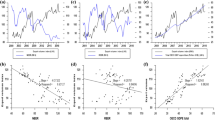Abstract
The paper argues that exchange rate reform is a vital supply-side factor in China's export growth. It contributes to China's export expansion by affording a realistic exchange rate and allowing freer access to foreign exchange, thereby leading to the reduction of anti-export bias and strong supply response. In an imperfect substitutes model, China's long-run export supply and demand functions are estimated in a system context. Evidence is found that the exchange rate reform is one of the most influential factors in China's long-run export expansion, inducing significant response of exports supply. In the short-run, the exchange rate reform and the export volume are also cross-linked through the error-correction process. China's exchange rate policy adjusts speedily to ensure the long-run equilibrium of the supply-side relationship and is likely to have played a dominant role in the adjustment. The study confirms, thanks to the exchange rate reform, China's exchange rate policy has benefited China's remarkable growth of exports before 1994.
Similar content being viewed by others
References
Bachrach, C. (1990), ‘Simultaneous estimation of export and domestic supply with an application to Israel industry’, Discussion Paper 9003, Falk Institute for Economic Research, Jerusalem.
Bahmani-Oskooee, M. (1986), ‘Determinants of international trade flows: The case of developing countries’, Journal of Development Economies 20, 107–125.
Balassa, B.E., Voloudakis, E., Eylaktos, P. and Suh, S.T. (1985), ‘Export incentives and economic growth in developing countries: An econometric investigation,’ The World Bank, DRD Discussion Paper 159.
Beenstock, M., Lavi, Y. and Ribon, S. (1994), ‘The supply and demand for exports in Israel’, Journal of Development Economies 44, 333–350.
Brada, J.C., Kutan, A.M. and Zhou, S. (1993), ‘China's exchange rate and the balance of trade’, Economics of Planning 26, 229–242.
Brender, A. (1992), ‘China's foreign trade behaviour in the 1980s: An empirical analysis’, IMF Working Paper, WP/92/5, International Monetary Fund.
Bond, M.E. (1985), ‘Export demand and supply for groups of non-oil developing countries’, IMF Staff Papers, March, 56–77.
Cai, Jin-niu (1995), ‘The quantity-based model of China's export expansion must be changed’, Theory and Practice of the Special Economic Zones 2, 23–24 (in Chinese).
Cheung, Y.-W. and Lai, K.S. (1993), ‘Finite-sample size of Johansen's likelihood ratio tests for cointegration’, Oxford Bulletin of Economics and Statistics 55, 313–328.
Ding, Jian-ping (1998), ‘China's foreign exchange black market and exchange flight: analysis of exchange rate policy’, The Developing Economies 36(1), 24–44.
Editorial Board, various years, Almanac of China's Foreign Economic Relations and Trade, Beijing: China Prospect Publishing House (in Chinese).
Fernald, J., Edison, H. and Loungani, P. (1998), ‘Was China the first domino? Assessing links between China and rest of emerging Asia’, International Discussion Papers 604, Board of Governors of the Federal Reserve System.
Goldstein, M. and Khan, M.S. (1978), ‘The supply and demand for exports: A simultaneous approach’, The Review of Economics and Statistics 60, 275–286.
Goldstein, M. and Khan, M.S., (1978), ‘Income and price effects in foreign trade’, in P.B. Kenen and R.W. Jones (eds.), Handbook of International Economics, Amsterdam, North-Holland.
Hendry, D.F. (1995), Dynamic Econometrics: Advanced Texts in Econometrics, Oxford, Oxford University Press.
Khan, M.S. (1974), ‘Imports and export demand in developing countries’, IMF Staff Papers, November, 678–693.
Khan, M.S. and Knight, M.D. (1988), ‘Import compression and export performance in developing countries’, Review of Economics and Statistics 70, 315–321.
Khor, H.E. (1993), ‘China's foreign currency swap market’, IMF Paper on Policy Analysis and Assessment.
Lu, M. and Zhang, Z. (2000), ‘Parallel exchange market as a transition mechanism for foreign exchange reform: China's experiment’, Journal of Applied Finance, 10, 123–135.
Marquez, J. and McNeilly, C. (1988), ‘Income and price elasticities for exports of developing countries’, The Review of Economics and Statistics 70, 306–314.
Mundell, R. A. (1996), ‘Inflation and growth in the transition economies’, in M. Guitian and R. A. Mundell, eds., Inflation and Growth in China: Proceedings of a Conference Held in Beijing, China, May 10- 12, Washington, DC., International Monetary Fund.
Muscatelli, V.A., Srinivasan, T.G. and Vines, D. (1992), ‘Demand and supply factors in the determination of NIE exports: A simultaneous error-correction model for Hong Kong’, Economic Journal 102, 467–477.
Muscatelli, V.A., Stevenson, A.A. and Montagna, C. (1995), ‘Modelling aggregate manufactured exports for some Asian newly industrialized economies’, The Review of Economics and Statistics 77, 47–55.
Reimers, H.E. (1992), ‘Comparisons of tests for multivariate cointegration’, Statistical Papers 33, 335–359.
Rosefielde, S. and Pfouts, R.W. (1990), ‘Ruble convertibility: Demand responsive exchange rates in a goal-directed economy’, European Economic Review 34, 1377–1397.
Rouis, M., Razzak, W. and Mollinedo, C. (1994), ‘The supply response to exchange rate reform in Sub-Saharan Africa: empirical evidence’, Policy Research Working Papers 1311, The World Bank.
Wang, H. (1993), China's Exports Since 1979, New York, St. Martin's Press.
Wang, H.-q, (1992), Theory and Practice of the Exchange Rate in China, Shanghai, People's Press of Shanghai (in Chinese).
Whitley, J. (1994), A Course in Macroeconomic Modelling and Forecasting, New York, Harvester Wheatsheaf.
Winters, L.A. (1984), ‘Separability and Specification of foreign trade functions’, Journal of International Economics 17, 239–263.
World Bank, (1994), China: Foreign Trade Reform, Washington, D.C., The World Bank.
Wu, S. (1994), ‘Exchange rate policies and its contribution to export growth in China, 1978- 1992’, Research Paper, Centre for Development Economics, Williams College.
Zhang, Z. (1997), Exchange Rate Reform in China: 1978- 1994, D. Phil. Thesis, Oxford University.
Author information
Authors and Affiliations
Rights and permissions
About this article
Cite this article
Zhang, Z. China's Exchange Rate Reform and Exports. Economics of Planning 34, 89–112 (2001). https://doi.org/10.1023/A:1017549828555
Issue Date:
DOI: https://doi.org/10.1023/A:1017549828555




